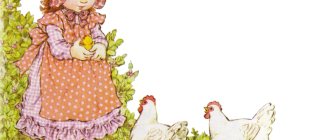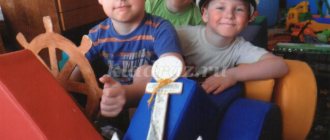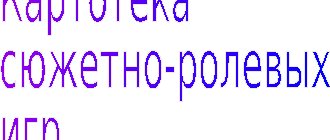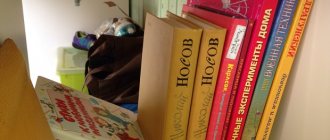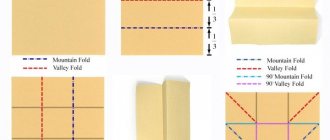Summary of didactic developmental games in the senior group
Abstract
conducting didactic educational games
in the senior group
Prepared and conducted by: teacher
With the help of games, develop attention, visual and auditory memory, imagination, and logical thinking. In the game “Fold the Square”, you can distinguish not only colors, but also their shades, put together parts from parts into a whole, squares of the same size; train ingenuity in solving the problem of parts of the whole, their possible relationships and relative positions. Develop the ability to analyze and synthesize with the help of the game “Fold the Pattern”, fold the pattern according to a verbal task, focusing on memory. In the game “Lights”, develop a sense of rhythm and concentration.
Material:
games “Fold the pattern”, “Fold the square”, “Lights”.
Progress:
Educator.
— Do you guys like to write different stories and stories? —Which book is more interesting to read? (which contains drawings, illustrations)
“And I also came up with interesting stories and would like you to make unusual drawings for them using cubes.” But you can draw unusual drawings only in the Unusual Country. Do you want to go there?
“But the road to this country is also unusual. It needs to be laid out from squares, and the squares must be assembled from parts of different shapes and sizes.
Game "Fold the square".
IN.
“You and I didn’t even notice how we got to the gates of the Unusual Country.” But what is it? The gate is closed, and above it there is an inscription: “Only for the one who correctly repeats the flickering of the magic lights on the castle, the gate will open.” Well, let's try again, otherwise we won't be able to get into this country.
Game "Lights".
IN.
- Look, the gate has opened and now we can draw unusual drawings for my stories.
Game "Fold the pattern."
"Boat trip".
Grandfather Zakhar lived with his grandson Misha in a small house on the seashore.
• Fold the “House” pattern.
Every day early in the morning, while Misha was still sleeping, grandfather Zakhar took his fishing rod with a large hook and went to the seashore to fish.
• Fold the “Hook”
(from the pattern “House, turning the cube”).
Waking up, Misha ran to the shore to help his grandfather bring the catch home. But the catch was small, and the fish were mostly small. “If we had a boat with a sail, then you and I would sail away from the shore, to where the big fish are,” the grandfather said. But there was no boat, and we had to fish from the shore every day. One day, while walking along the shore, Misha saw something dark washing onto the shore by a wave. As he came closer, he realized that it was an old leaky boat. Overjoyed, Misha pulled the boat ashore and quickly ran after his grandfather. Together they brought what was left of it to the house and work began. The boat was dried, repaired, tarred, and new oars and mast were made. Grandfather Zakhar took a real sail out of the chest. The ship was ready.
• Fold the “Boat”
(from the “Hook” pattern by turning 2 cubes). All the next day the fishermen prepared their gear to go out to sea early in the morning.
• Fold the “Hook” pattern.
The next morning turned out to be clear, a light breeze was blowing, and grandfather Zakhar and Misha went on a real sea fishing trip. The shore went further and further, turning into a thin strip, until it disappeared completely. There were a lot of fish here, and the fishermen did not notice how the sky became cloudy and a thunderstorm began.
• Fold the “Lightning” pattern.
A storm has begun. Having quickly removed the sail, grandfather Zakhar and Misha held tightly to the edges of the boat so that they would not be washed away by the wave. The small boat was spun in all directions and thrown from wave to wave. The storm ended as suddenly as it began. Having scooped water out of the boat, grandfather Zakhar and Misha looked around. The expanse of water spread out all around. Where to go? (The compass was washed away by a wave during a storm).
Suddenly Misha shouts: “Grandfather, look, the birds are flying!” Indeed, a flock of birds flew high in the sky above them.
• Fold the “Bird” pattern.
My grandfather lived a long life; he observed the habits of animals and birds more than once. He knew that birds fly from shore to shore in a straight line during long flights. Just how to determine: a flock of birds is approaching the shore or flying away from it?
“I guessed it,” said Misha. Birds take flight early in the morning. The shore was not very far away, so they could not have just started. This means they were flying towards the shore. Having sailed in the direction indicated by the birds, the fishermen saw the shore and a flag on the roof of the house.
• Fold the “Flag” pattern.
At home, grandfather Zakhar and Misha, in order to quickly warm up, sat down to drink hot tea with sweets.
• Fold the “Candy” pattern.
Fizminutka:
IN.
- Guys, look, something small, round is falling from the sky. Stretch your left arm up, open your palm, and with your right hand let's catch these small dots. We hit the left palm with the thumb of the right hand: “One!”, with the index finger and thumb: “Two”; middle, index and thumb: “Three”; ring, middle, index and major: “Four!”; With five fingers: “Rain!”, clap our hands: “Hail!”, stamp our feet and clap: “Thunder!”.
- Let's hide from the rain at Winnie the Pooh's.
Game "Fold the pattern."
"Winnie the Pooh and his friends."
One day, Winnie the Pooh was sitting at home and feeling sad. All his friends were busy - some worked in the garden and could not go for a walk, some went into the forest to pick mushrooms. Winnie the Pooh decided not to waste time and prepare gifts for his friends: he decided to embroider napkins with multi-colored threads. But at home there were only red and white threads. Let's embroider together.
• Fold a red square napkin out of 9 cubes.
Winnie the Pooh prepared his first gift for his best friend Piglet. He embroidered the first letter of his name. Which one?
• Lay out the pattern: red letter P on a white background.
The second gift was intended for Tigra. What letter did Winnie the Pooh embroider?
• Lay out the pattern: letter T.
Then he first embroidered a mushroom for his friends.
• Lay out the “Mushroom” pattern.
Then he embroidered a butterfly.
• Lay out the “Butterfly” pattern.
— When Winnie the Pooh gave embroidered napkins to his friends, they really liked them.
These are the interesting, unusual drawings we drew. But we must return back from the Unusual Country and again along the magical path. We will lay out this path in a chain of cubes (following the pattern). Whoever posts it correctly will return to kindergarten.
• Fold a “chain” of cubes according to the pattern.
.
Get text
Developmental lesson with pupils of the senior group of kindergarten.
Abstract
Developmental lesson for pupils of the senior group of kindergarten
.
Author -
teacher-psychologist MBDOU "VTsRR - d/s No. 1" Boltova Elena Ilyinichna
Target:
create conditions for children’s cognitive activity in which they can realize
Tasks:
— learn to listen carefully to the task and group objects according to basic characteristics;
— train perception and attention;
- compose short stories based on pictures, develop coherent speech;
— correctly evaluate your actions and the behavior of others (life safety).
Equipment:
— demonstration material (book with color illustrations, story pictures);
— “Wonderful bag” with cards on the topic “insects”;
-ball.
Educational areas:
speech, social-communicative, cognitive
Progress of the lesson.
Greetings
to create a positive psycho-emotional mood in students.
Good morning to the sun and birds!
Good morning to smiling faces!
And everyone becomes kind, trusting,
Good morning lasts until evening!
Game "Wonderful bag"
as an interesting moment and the mood of the students on this topic. Each child is asked to take 1 card from the bag in turn and name the insect, its difference from others and its significance in wildlife. This game activates students' motivation on the topic. If mistakes are made in the name of an insect or its distinctive qualities, it is necessary to offer preschoolers help. The task is performed by all children in turn, standing in a circle or sitting at a table.
Game task “Name the insects.”
Children are asked to find all the insects in the picture and name them. The level of children's knowledge of insects, the formation of their perception and the level of development of attention are determined.
The criteria for achieving the objectives are: the activity of the students, the correct completion of the task by all participants in the process, the interest of preschoolers.
If it is difficult to complete a task, verbal or visual assistance is provided and other children are encouraged to provide assistance.
The work is carried out frontally; for pupils with a lower level of attention, more time is given to complete the task.
To relieve tension and static, physical exercise and finger exercises are performed.
Game "Evaluate the action."
Pupils are invited to look at the picture and take turns making up a story based on the plot picture, answering the questions: “What are the children doing? How is this dangerous?
Conditions are created for preschoolers to develop the ability to relate a question to a picture and correctly evaluate their actions and the behavior of others. To stimulate students’ active speech, leading questions are asked such as: “Why can’t this be done? What can happen? What actions are these: good or bad? Pupils should be encouraged to independently choose the correct safe behavior.
Game "It's the other way around."
The pupils are asked to say the word backwards after catching the ball. For example, good - bad, hot - cold, kind - evil, etc.
This game helps develop students' thinking, speech, and attention. It is advisable to carry it out at a fast pace. Tips from other students are welcome. It is necessary to ensure that each student names the words antonyms.
Summarizing. Pupils are invited to name as many words as possible “on the contrary” - antonyms at home with their parents and name them at the next lesson.
The success of completing the task depends on the number of antonyms named.
Farewell and good luck.
Used Books:
Zemtsova O.N. “Developing Attention” LLC Publishing Group “Azbuka-Atticus” 2012
